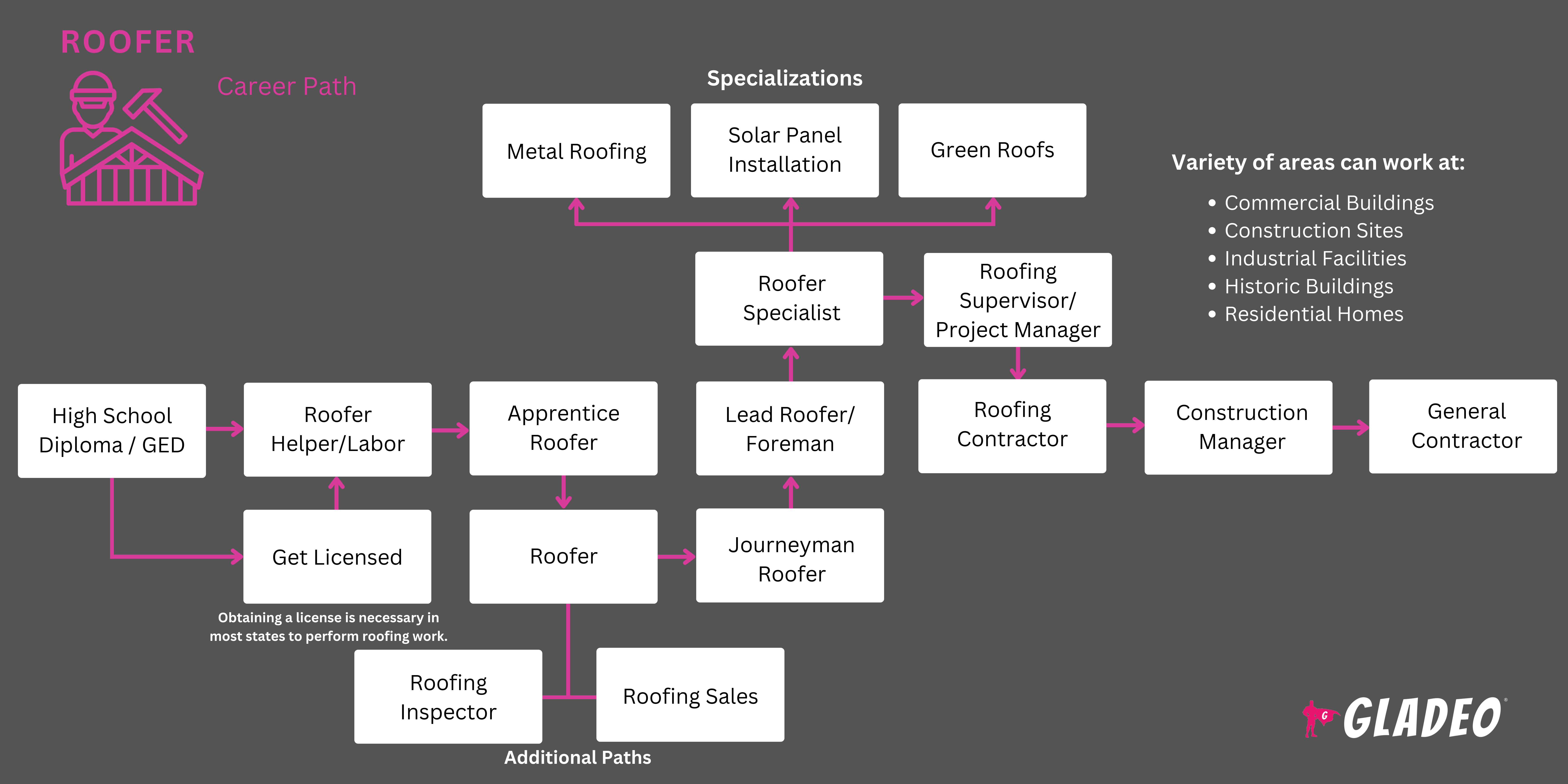Mga spotlight
Komersyal na Roofer, Industrial Roofer, Metal Roofing Mechanic, Residential Roofer, Roof Mechanic, Roof Service Technician, Roofer, Roofing Technician, Sheet Metal Roofer
Ang mga gusali ay itinayo sa mga yugto, simula sa ilalim na pundasyon at gumagana hanggang sa mga dingding, beam, at iba pang bahagi ng balangkas. Susunod ay ang bubong - ang huling piraso na kailangan upang selyuhan ang gusali at protektahan ang interior mula sa mga elemento. Ang bubong ay hindi lamang pinipigilan ang ulan at hangin, nakakatulong din itong ipamahagi ang timbang nang pantay-pantay sa buong istraktura, na nagpapatatag sa mga pader laban sa mga puwersa tulad ng hangin o niyebe.
Dahil ang pagbububong ay nangangailangan ng katumpakan at kadalubhasaan, ito ay isang trabaho para sa mga dalubhasang manggagawa na tinatawag na, akala mo, Mga Bubong! Gumagamit ang mga bubong ng mga materyales tulad ng shingle, aspalto, metal, at bitumen upang matiyak na ang mga bubong ay hindi tinatablan ng panahon, matipid sa enerhiya, kaakit-akit sa paningin, at hanggang sa code.
Kasabay ng pag-install ng mga bagong bubong, ginagawa din ng mga Roofers ang mga kritikal na gawain ng pagpapanatili at pag-aayos ng mga lumang bubong, na tinitiyak ang pangmatagalang tibay ng mga gusali. Dahil nagtatrabaho sila sa matataas na elevation at may iba't ibang tool, ang kaligtasan ay isang pangunahing priyoridad upang maiwasan ang mga aksidente!
- Pagtulong na protektahan ang mga tahanan at negosyo mula sa pinsala ng panahon
- Nagtatrabaho sa labas at manatiling aktibo
- Mga pagkakataong magpakadalubhasa sa iba't ibang materyales at teknik sa bubong
- Lumalaki ang pangangailangan para sa matipid sa enerhiya at napapanatiling mga opsyon sa bubong
Oras ng trabaho
Ang mga bubong ay karaniwang gumagana nang full-time at maaaring makaranas ng pana-panahong pagbabagu-bago depende sa lagay ng panahon. Maaaring kailanganin ang overtime sa mga panahon ng abalang o emergency repair.
Mga Karaniwang Tungkulin
- Makipagpulong sa mga stakeholder para matukoy ang mga kinakailangan, gaya ng pag-install ng bubong sa bagong gusali o pagpapalit (o pag-aayos) ng kasalukuyang bubong)
- Suriin ang mga potensyal na materyales sa bubong, badyet, at timeframe ng proyekto.
- Tandaan ang mga sukat ng bubong ng mga bagong proyekto sa pagtatayo. Sukatin at suriin ang mga umiiral na bubong, kung kinakailangan.
- Tantyahin ang saklaw ng trabahong kailangan, kabilang ang mga materyales, paggawa, at iba pang gastos o mga espesyal na salik gaya ng pag-install ng solar panel. Magbigay ng mga panipi sa mga kliyente, kung kinakailangan.
- Mag-set up ng scaffolding at hagdan upang matiyak ang ligtas na pag-access sa mga lugar sa bubong.
- I-clear ang mga bubong ng mga labi o niyebe, kung kinakailangan.
- Alisin ang mga luma o sirang materyales sa bubong, kabilang ang mga shingle, tile, o metal sheet.
- Palitan ang nabubulok o nasira na plywood, joists, at iba pang bahagi ng istruktura kung kinakailangan.
- Mag-install ng mga vapor barrier o insulation layer para mapahusay ang energy efficiency at maprotektahan laban sa moisture.
- Mag-install ng mga sistema ng bentilasyon sa bubong, tulad ng mga ridge vent o turbine, upang mapabuti ang daloy ng hangin at maisaayos ang temperatura.
- I-align ang mga materyales sa bubong nang tumpak sa mga gilid ng bubong. Gupitin ang mga materyales upang magkasya sa paligid ng mga chimney, vent, skylight, at iba pang mga sagabal.
- I-secure ang mga materyales sa bubong gamit ang mga pako, turnilyo, o pandikit.
- Ikabit ang waterproof flashing strips sa mga joints at seams para makagawa ng watertight seal.
- Lagyan ng bubong na semento o caulk upang takpan ang mga nakalantad na pako o mga ulo ng turnilyo.
Karagdagang Tungkulin
- Mag-install ng bahagyang magkakapatong na mga layer ng materyales sa bubong gamit ang mga linya ng chalk o iba pang mga gabay para sa tamang pagkakahanay.
- Maglagay ng mga protective coating o lamad sa mga bubong na hindi tinatablan ng tubig at maiwasan ang pagkasira ng tubig.
- Mag-install, mag-ayos, o magpalit ng single-ply roofing system na gawa sa mga materyales tulad ng binagong plastic o elastomeric sheet.
- Mop o magbuhos ng mainit na aspalto o alkitran sa mga patag na bubong para makagawa ng waterproof na base layer.
- Makinis na magaspang o hindi pantay na ibabaw ng bubong upang ihanda ang mga ito para sa mga waterproofing treatment o coatings.
- Mag-install ng mga skylight o solar panel sa mga bubong, kung wastong sinanay na gawin ito.
- Lagyan ng graba o pebbles ang huling layer ng bubong upang mapahusay ang tibay.
- Mentor ng mga bagong Roofers. Manatiling nakasubaybay sa mga bagong materyales at uso.
Soft Skills
- Aktibong pakikinig
- Pansin sa detalye
- Balanse
- Kumportable sa pag-akyat at taas
- Kritikal na pag-iisip
- Serbisyo sa customer
- pagiging maaasahan
- Kagalingan ng kamay
- Pagsasarili
- Pagsubaybay
- Pisikal na tibay at lakas
- Pagtugon sa suliranin
- Pamamahala ng proyekto
- Pagtitiyak ng kalidad
- May kamalayan sa kaligtasan
- Pagtutulungan ng magkakasama
- Pamamahala ng oras
Teknikal na kasanayan
- Math, tulad ng pangunahing aritmetika upang kalkulahin ang lugar ng bubong at mga pangangailangan ng materyal, geometry upang sukatin ang mga anggulo at slope, at mga fraction para sa pagputol ng mga materyales
- Kaalaman sa mga sistema ng bubong at materyales tulad ng aspalto, metal, at shingles
- Kahusayan sa tool (tulad ng mga nail gun, martilyo sa bubong, at mga tool sa paggupit)
- Mga protocol sa kaligtasan at mga pamantayan ng OSHA
- Pagbabasa ng blueprint upang maunawaan ang mga sukat ng bubong, anggulo, at mga kinakailangang materyales
- Mga diskarte sa pag-install para sa mga shingle, metal panel, at insulation
- Pagbabasa ng blueprint
- Pagtatantya ng mga materyales at gastos
- Kaalaman sa aplikasyon ng malagkit
- Pag-unawa sa paggalaw ng kahoy dahil sa mga pagbabago sa kahalumigmigan
- Mga kumpanya sa pagtatayo ng tirahan
- Mga kontratista sa bubong
- Mga ahensya ng gobyerno
- Mga departamento ng pagpapanatili ng malalaking pasilidad
Ang pagbububong ay maaaring maging matrabahong trabaho na kinabibilangan ng pag-angat, pag-akyat, at pagtatrabaho sa matataas – kadalasan sa mainit, malamig, o basang kondisyon ng panahon. Dapat nilang sundin ang mahigpit na mga alituntunin sa kaligtasan upang maiwasan ang mga aksidente at pinsala, na ginagawang mahalaga ang kamalayan sa kaligtasan.
Sa panahon ng taglamig, maaaring kakaunti ang trabaho sa mga lugar na may malakas na snowfall o masyadong maraming yelo. Bilang resulta, maaaring kailanganin ng mga Roofer na magplano nang maaga sa pananalapi upang mabayaran nila ang kanilang mga gastusin sa pamumuhay sa mga ganoong oras.
Sa kabuuan, ang trabaho ay maaaring maging mahirap ngunit kapaki-pakinabang para sa mga nag-e-enjoy sa hands-on na trabaho at panlabas na kapaligiran!
Maraming mga uso sa industriya ng bubong ay nakatuon sa kahusayan ng enerhiya at pagpapanatili. Halimbawa, ang mga may-ari ng bahay at mga negosyo ay lalong pumipili ng mga opsyon sa berdeng bubong tulad ng mga cool na bubong na sumasalamin sa sikat ng araw upang mabawasan ang pagsipsip ng init at mga solar roofing system na nagsasama ng mga photovoltaic panel. Nakakatulong ang mga solusyong ito sa pagtitipid ng enerhiya at nagdaragdag ng pangmatagalang halaga sa mga gusali.
Binabago din ng mga makabagong materyales ang laro. Gumagamit na ngayon ang mga roofing system ng mas maraming weather-resistant na materyales tulad ng thermoplastic polyolefin (TPO) at modified bitumen, na nag-aalok ng tibay at kahusayan sa enerhiya. Ang mga reflective coatings at self-healing na materyales ay nagpapahaba ng buhay ng bubong at binabawasan ang pangangailangan para sa madalas na pag-aayos.
Bumubuti rin ang kaligtasan, salamat sa mga advanced na harness at teknolohiya ng drone para sa mas ligtas na mga inspeksyon. Panghuli, ang mga Roofers ay nakikinabang mula sa mga digital na tool na nagpapahusay sa pagpaplano at katumpakan, na tinitiyak ang pagsunod sa mga code ng gusali.
Sa kanilang mga kabataan, maaaring nasiyahan ang mga Roofer sa mga hands-on na aktibidad, pagtatrabaho sa mga tool, at mga proyekto sa labas. Maaaring nagustuhan nila ang paggawa ng mga gawaing nangangailangan ng tibay at katumpakan.
- Ang mga bubong ay karaniwang nangangailangan ng kahit isang diploma sa mataas na paaralan o GED.
- Nakatutulong na kumuha ng mga kurso tulad ng tool safety, construction, o roofing techniques sa high school, vocational school, trade school, o community college.
- Maaaring kailanganin ng mga aplikante na magkaroon ng wastong lisensya sa pagmamaneho upang makapunta sila sa iba't ibang lokasyon ng trabaho sa oras.
- Sa ilang pagkakataon, maaaring kailanganin din ang isang komersyal na lisensya sa pagmamaneho (CDL).
- Karamihan sa mga naghahangad na Roofer ay nagsisimula bilang mga katulong at tumatanggap ng hands-on na pagsasanay mula sa mas may karanasang manggagawa. Ang ilan ay nagtatrabaho at natututo sa pamamagitan ng mga naka-sponsor na apprenticeship tulad ng mga inaalok ng United Union of Roofers, Waterproofers at Allied Workers .
- Maaaring mangailangan ang mga employer ng mga bagong Roofers upang kumpletuhin ang pagsasanay sa kaligtasan sa Occupational Safety and Health Administration o mga kursong GAF CARE Contractor Training Center .
- Tandaan, maraming mga estado ang nangangailangan ng mga Roofers na kumuha ng lisensya sa isang punto sa kanilang mga karera. Maaaring kabilang sa mga opsyon sa paglilisensya ang isang lisensya sa tirahan, isang komersyal na lisensya, o isang kumbinasyon ng lisensya na sumasaklaw sa parehong uri ng trabaho.
- Upang maging kwalipikado para sa isang lisensya, ang mga Roofers ay karaniwang dapat pumasa sa isang pagsusulit sa kalakalan at magbigay ng katibayan ng pagkumpleto ng isang tiyak na bilang ng mga proyekto sa loob ng isang tiyak na takdang panahon.
- Ang patunay ng saklaw ng seguro sa pananagutan at isang surety bond ay iba pang potensyal na kinakailangan upang makakuha ng lisensya.
- Ang mga bubong na may karanasan ay maaaring mag-aplay para sa sertipikasyon mula sa National Roofing Contractors Association PROCertification program.
- Kasama sa iba pang mga sertipikasyon ang Rehistradong Consultant ng Bubong ng International Institute of Building Enclosure Consultants.
- Isaalang-alang ang halaga ng matrikula, mga diskwento, at mga pagkakataon sa lokal na iskolarship (bilang karagdagan sa tulong na pederal).
- Isipin ang iyong iskedyul at kakayahang umangkop kapag nagpapasya kung mag-e-enroll sa isang on-campus, online, o hybrid na programa. Kakailanganin mo ng maraming hands-on na pagsasanay hangga't maaari mong makuha.
- Tingnang mabuti ang mga pasilidad at kagamitan ng programa. Tingnan ang mga parangal at mga nagawa ng faculty ng programa.
- Subukang basahin ang mga review mula sa mga nakaraang mag-aaral.
- Suriin ang mga istatistika ng paglalagay ng trabaho at mga detalye tungkol sa alumni network ng programa.
Para sa mga naghahangad na Roofers, narito ang isang kapaki-pakinabang na gabay sa mga kasanayan at hakbang na dapat gawin:
- Kumuha ng mga nauugnay na kurso sa high school gaya ng English, general math (aritmetika, fractions, decimals, ratios, proportions), geometry, at physics. Mahalaga rin ang woodworking o shop classes, blueprint reading, at drafting.
- Ang mga mag-aaral sa high school ay kadalasang maaaring kumuha ng community college o vocational training classes nang sabay-sabay. Kumonsulta sa iyong tagapayo sa paaralan para sa mga detalye.
- Magkaroon ng mga kasanayan sa hands-on sa pamamagitan ng pag-aaral na ligtas na gumamit ng mga hand at power tool sa ilalim ng pangangasiwa ng isang propesyonal na Roofer.
- Makakuha ng praktikal na karanasan sa trabaho sa pamamagitan ng part-time na mga trabaho sa konstruksiyon, entry-level laborer positions, o apprenticeships.
- Magsanay sa pamamagitan ng pagtatrabaho sa mga proyekto sa pagbububong sa bahay o kasama ang mga kaibigan upang makakuha ng hands-on na karanasan.
- Isaalang-alang ang pagboboluntaryo sa mga organisasyon tulad ng Habitat for Humanity upang makakuha ng karagdagang karanasan.
- Palawakin ang iyong kaalaman sa pagbububong sa pamamagitan ng mga online na klase, mga video sa pagtuturo, o mga channel sa YouTube na nakatuon sa mga kasanayan sa pagtatayo.
- Turuan ang iyong sarili sa pamamagitan ng mga aklat, magazine na may kaugnayan sa bubong (tulad ng Roofing Contractor ), mga blog, at mga forum ng talakayan.
- Magtanong sa isang propesyonal na Roofer kung mayroon silang oras para sa isang panayam sa impormasyon upang makakuha ng mga insight sa kalakalan.
- Magkaroon ng kamalayan na maraming mga tagapag-empleyo sa industriya ng konstruksiyon, kabilang ang bubong, ay maaaring magsagawa ng mga pagsusuri sa gamot bago ang pagtatrabaho upang matiyak ang kaligtasan sa lugar ng trabaho, lalo na kapag gumagamit ng mga hand at power tool. Ang ilang mga apprenticeship o unyon ay maaari ding mangailangan ng drug testing.

- Mag-ipon ng maraming nauugnay na karanasan hangga't maaari sa paaralan o sa pamamagitan ng boluntaryong trabaho, part-time na trabaho, o isang apprenticeship.
- Tingnan ang mga portal ng trabaho tulad ng Glassdoor , Indeed , USAJOBS , o SimplyHired .
- Maghanap ng mga pagkakataon sa apprenticeship sa Apprenticeship.gov .
- I-screen nang mabuti ang mga ad ng trabaho upang matiyak na natutugunan mo ang mga kinakailangan.
- Halimbawa, kung ang ad ng trabaho ay naglilista ng lisensya sa pagmamaneho bilang isang "kinakailangan," kakailanganin mong kunin ang sa iyo bago mag-apply.
- Kung ang ad ng trabaho ay naglilista ng pagkakaroon ng lisensya sa pagmamaneho bilang "ginusto" o "nais," maaari ka pa ring mag-aplay ngunit dapat na ipaalam sa kanila kung nasa proseso ka ng pagkuha ng iyong lisensya.
- Ituon ang iyong resume sa mga nauugnay na karanasan sa trabaho at akademiko.
- Isama ang mga keyword sa iyong resume/application, gaya ng:
- Pag-install ng Flash
- Mga Sistemang Patag na Bubong
- Pag-detect ng Leak
- Metal Roofing
- Mga Protokol sa Kaligtasan sa Bubong
- Pagsusuri sa Bubong
- Pag-install ng Bubong
- Pag-aayos ng Bubong
- Pagpapalit ng Shingle
- Hindi tinatablan ng tubig
- Suriin ang mga template ng resume ng Roofer upang makakuha ng mga ideya para sa pag-format at pagbigkas ng parirala.
- Hanapin ang mga karaniwang tanong sa panayam ng Roofer .
- Humingi ng tulong sa mga tauhan ng mga serbisyo sa karera ng iyong paaralan sa mga resume, kunwaring panayam , at paghahanap ng trabaho. Maaaring may koneksyon sila sa mga lokal na unyon na nag-aalok ng mga apprenticeship!
- Kung nag-aaplay para sa isang apprenticeship ng unyon, basahin nang mabuti ang mga tagubilin sa aplikasyon bago punan ang anuman.
- Tandaan, “hindi inaasahan ng karamihan sa mga unyon na magiging eksperto ka sa iyong industriya,” kapag nag-aplay ka para sa isang apprenticeship,” sabi ng Indeed .
- Tandaan, maraming employer sa mga skilled trade ang nagsasagawa ng mga drug test bilang bahagi ng kanilang proseso sa pag-hire upang mabawasan ang mga panganib. Ang mga union apprenticeship ay maaari ding mag-utos ng mga pre-apprenticeship na mga pagsusuri sa droga o mga random na pagsusuri sa droga.
- Abutin ang iyong network upang ipaalam sa kanila na naghahanap ka ng mga pagkakataon.
- Makisali sa mga online na forum at magtanong ng mga tanong sa payo sa karera.
- Tanungin ang iyong mga propesor, superbisor, at mga kapantay kung magsisilbi silang mga personal na sanggunian.
- Palaging magsuot ng angkop para sa tagumpay sa pakikipanayam sa trabaho!
- Ang mga bubong ay maaaring magpakita ng pamumuno sa pamamagitan ng patuloy na paggawa ng mataas na kalidad na trabaho, pagiging on-site sa oras, pakikipagtulungan nang epektibo sa mga miyembro ng koponan, at pagtatapos ng mga proyekto sa oras at sa loob ng badyet.
- Kumuha ng lisensya, kung kinakailangan ng iyong estado at natutugunan mo ang mga kwalipikasyon.
- Makipag-usap sa iyong superbisor tungkol sa iyong mga layunin sa karera. Ipaalam sa kanila na handa kang patumbahin ang anumang pagsasanay na iminumungkahi ng iyong employer, tulad ng mga sikat na certification tulad ng National Roofing Contractors Association PROCertification o OSHA 30-Hour Construction na pagsasanay .
- Pag-isipang magsagawa ng mga espesyal na certification sa mga lugar tulad ng berdeng bubong, metal na bubong, o komersyal na mga sistema ng bubong.
- Kumuha ng ilang advanced na kurso sa GAF CARE Contractor Training Center . Magtanong tungkol sa pagbabayad ng matrikula o iba pang benepisyong pang-edukasyon na inisponsor ng employer upang mabayaran ang iyong mga gastos habang patuloy kang nag-aaral.
- Makakuha ng karanasan sa paggamit ng iba't ibang materyales sa bubong at panatilihing napapanahon sa mga bagong teknolohiya at pamamaraan.
- Laging unahin ang kaligtasan at huwag mag-shortcut. Ang isang makabuluhang sakuna o pinsala ay maaaring makapinsala sa iyong buong karera.
- Kumuha ng mga kurso sa pamamahala ng proyekto upang pangasiwaan ang mas malalaking proyekto at pamahalaan ang mga badyet, timeline, at tauhan nang mas epektibo.
- Kumuha ng mga kasanayan sa pagtantya ng mga gastos at pag-bid para sa mga proyekto upang maging kwalipikado para sa mas mataas na antas ng mga posisyon o pagpapatakbo ng isang negosyo.
- Matuto ng mga nauugnay na trade tulad ng waterproofing, insulation, o pag-install ng solar panel.
- Alamin ang iyong sarili sa roofing software at mga tool sa teknolohiya na nagpapahusay sa pagpaplano ng proyekto, pagsunod sa kaligtasan, at mga komunikasyon sa customer.
- Bumuo ng isang propesyonal na portfolio na nagpapakita ng iyong pinakamahusay na trabaho, mga testimonial ng kliyente, at rekord ng kaligtasan.
- Kumuha ng lisensya ng kontratista kung kinakailangan upang ma-access ang mga pagkakataon at mas mataas na bayad na mga proyekto.
- Mangasiwa at magturo ng mga junior Roofers. Manguna sa pamamagitan ng halimbawa at palaging magsuot ng iyong personal na kagamitan sa proteksyon kung kinakailangan!
- Panatilihing aktibo sa mga propesyonal na organisasyon tulad ng National Roofing Contractors Association upang matutunan at mapalago ang iyong network.
- Kung kinakailangan upang umakyat, mag-aplay para sa mga trabaho sa mas malalaking organisasyon na maaaring may higit na potensyal na umunlad—o maglunsad ng iyong sariling negosyo.
Mga website
- Apprenticeship.gov
- Mga Kaugnay na Tagabuo at Kontratista
- Mga Kaugnay na Pangkalahatang Kontratista ng Amerika
- Pinagsasama ang Natitirang Pagkakataon sa Mga Kasanayang Tradeswomen
- Mga Koneksyon sa Karera
- GAF
- Mga helmet sa Hardhats
- Home Builders Institute
- Job Corps
- Pambansang Samahan ng mga Tagabuo ng Tahanan
- National Association of the Remodeling Industry
- National Building Trades Union
- National Roofing Contractors Association
- NCCER
- Pangangasiwa sa Kaligtasan at Kalusugan sa Trabaho
- Kontratista ng Bubong
- United Union of Roofers, Waterproofers, at Allied Workers
Mga libro
- Pagbububong sa Tamang Daan, ni Steven Bolt
- Ang Kumpletong Gabay sa Roofing at Siding, ni Black & Decker
- Ang NRCA Roofing Manual, ng NRCA
Ang mga bubong ay mahahalagang miyembro ng industriya ng konstruksiyon, ngunit hindi lahat ay gustong magtrabaho sa taas o sa labas sa lahat ng oras. Para sa mga nag-iisip ng mga hands-on na trabaho maliban sa pagbububong, tingnan ang aming listahan ng mga kaugnay na karera sa ibaba!
- karpintero
- Taga-install ng Ceiling Tile
- Inspektor ng Konstruksyon at Gusali
- Manggagawa sa Konstruksyon
- Drywall Installer
- Electrician
- Taga-install ng Sahig
- Furniture Finisher
- Pangkalahatang Maintenance at Repair Worker
- HVAC Technician
- Insulation Worker
- Masonry Worker
- Gumagawa ng Modelo
- Plasterer
- Sheet Metal Worker
- Solar Photovoltaic Installer
- Structural Metal Fabricator at Fitter
- Tile at Stone Setter
- Welder
- Woodworking Machine Setter, Operator, at Tender
Newsfeed

Mga Tampok na Trabaho

Mga Online na Kurso at Tool

Mga Inaasahan sa Taunang Sahod
Nagsisimula ang mga bagong manggagawa sa paligid ng $73K. Ang median na suweldo ay $75K bawat taon. Ang mga manggagawang may mataas na karanasan ay maaaring kumita ng humigit-kumulang $99K.
Mga Inaasahan sa Taunang Sahod
Nagsisimula ang mga bagong manggagawa sa paligid ng $61K. Ang median na suweldo ay $65K bawat taon. Ang mga manggagawang may mataas na karanasan ay maaaring kumita ng humigit-kumulang $71K.
Mga Inaasahan sa Taunang Sahod
Nagsisimula ang mga bagong manggagawa sa paligid ng $65K. Ang median na suweldo ay $66K bawat taon. Ang mga may karanasang manggagawa ay maaaring kumita ng humigit-kumulang $79K.
Mga Inaasahan sa Taunang Sahod
Nagsisimula ang mga bagong manggagawa sa paligid ng $62K. Ang median na suweldo ay $65K bawat taon. Maaaring kumita ng humigit-kumulang $77K ang mga may karanasang manggagawa.






